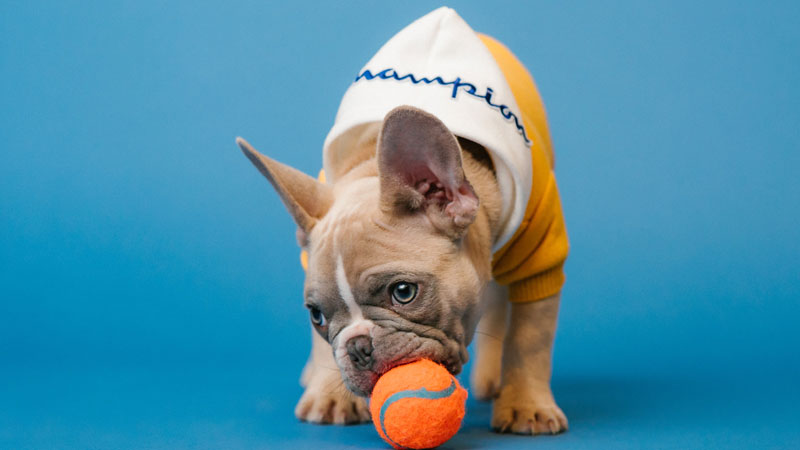- Size
- Smallest
- Small
- Small to Medium
- Medium
- Large
- Giant
- Characteristics
- Smartest
- Hypoallergenic
- Fluffy
- Best Guard
- Best Family
- Best for Kids
- Low Shedding
- Healthiest
- Police Dogs
- Most Calm
- Quietest
- Color
- White
- Black
- Grey
- Brown
- Blue
- Red
- Coat
- Hairless
- Short
- Long
- Origin
- Japan
- China
- Australia
- Germany
- Italy
- United States
- France
- Group
- Hound
- Terrier
- Herding
- Toy
- Working
- Sporting
5 Easy Steps: How To Teach Your Puppy To Fetch

Photo by Karsten Winegeart on Unsplash
For many dog owners, the image of their furry friend enthusiastically fetching a ball is a quintessential part of the canine-human bond. However, not all dogs naturally grasp the concept of fetch, and some may need a bit of guidance to transform this activity into an enjoyable pastime. In this comprehensive guide, we'll explore the step-by-step process of teaching your dog to fetch, turning each training session into a rewarding experience for both you and your canine companion.
Supplies You'll Need
Before embarking on the journey of fetch training, gather the essential supplies to ensure a successful and enjoyable learning experience:
An array of toys
High-value treats
Clicker (if using clicker training)
How to Train Your Dog to Fetch
Fetching is not only a physical activity but also a mental exercise for your dog. To master the art of fetch, break down the training process into two fundamental steps: teaching "hold" and transitioning into fetching.
Teaching 'Hold'
Introduction to the Toy: Sit on the floor with your dog facing you, holding a toy in your hand. Show the toy to your dog to pique their interest.
Reward Interest: When your dog investigates the toy, offer praise or use a clicker followed by a treat. In this initial stage, reward any interaction with the toy.
Incremental Criteria: Gradually increase the criteria by waiting until your dog sniffs the toy before clicking, praising, or treating. Progress to waiting for your dog to put their mouth on the toy before reinforcement.
Building Duration: Work on building the duration of holding by delaying the click or praise slightly. Gradually extend the time your dog keeps their mouth on the toy before offering positive reinforcement.
Introduce Verbal Cue: Once your dog consistently holds the toy until reinforcement, introduce a verbal cue like "hold" to associate the action with a command.
Hands-off Approach: Begin moving your hands off the toy, quickly placing your hand back on it before your dog drops it. Praise, take the object, and reward your dog with a treat.
Patience and Pace: Ensure success by progressing at your dog's pace, building the time they hold the toy slowly. Multiple repetitions of short holds are more effective than expecting one long hold.
Teaching Fetch
Now that your dog has mastered "hold," it's time to transition into the fetching phase.
1. Outstretched Palm: Hold the toy out to your dog in your outstretched palm and ask them to "hold." If they take the toy, click or praise and treat. If not, practice the "hold" skills until they are ready.
2. Introduction of a Verbal Cue: Successfully take the toy from your hand, place it on the floor in front of them, and ask your dog to "hold" the toy. When they pick it up, immediately praise or click. Introduce a new verbal cue like "get it" or "fetch."
3. Gradual Distance Increase: Start by placing the toy right next to you and very slowly increase the distance. The goal is to break down the retrieval process into small, manageable steps to ensure success.
4. Variety of Toys: As your dog becomes proficient, introduce a variety of toys such as balls, plush toys, or rope toys. Alternate between asking your dog to fetch a toy placed away from you and throwing the toy.
5. Consistency and Patience: Consistent practice and patience are key to refining the skill of fetching. With time and repetition, your dog will develop a smooth cued retrieve of any toy.
Remember that, for dogs, the ultimate reward isn't the game itself but the positive reinforcement received during and after fetching. Keep rewarding their fetching behavior with treats to solidify the connection between the activity and a delightful experience.
Conclusion
Teaching your dog to fetch is a journey of understanding and communication. Through patience, consistency, and positive reinforcement, you can unlock the joy of fetch for both you and your furry companion. Embrace the learning process, celebrate small victories, and cherish the moments of connection as you embark on this delightful adventure with your dog.
You May Also Like
 Dog BehaviorDo Dogs Learn Fetch Naturally?
Dog BehaviorDo Dogs Learn Fetch Naturally? Help & AdviceHow Do You Teach A Stubborn Dog To Fetch?
Help & AdviceHow Do You Teach A Stubborn Dog To Fetch? Dog BehaviorWhat Age Do Dogs Learn Fetch?
Dog BehaviorWhat Age Do Dogs Learn Fetch? Dog Training TipsThe Place Command: Teach Your Dog to Go to Their Place
Dog Training TipsThe Place Command: Teach Your Dog to Go to Their Place Dog Training TipsDog Tricks: Teach Your Dog to High Five
Dog Training TipsDog Tricks: Teach Your Dog to High Five Dog Training Tips How to Teach a Dog to Come When Called: The Recall Command Guide
Dog Training Tips How to Teach a Dog to Come When Called: The Recall Command Guide